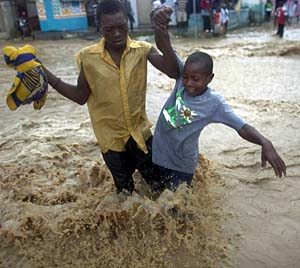Haiti cholera deaths over 500
Last Updated: Sunday, November 7, 2010 | 9:53 PM ET

A cholera outbreak in Haiti has killed more than 500 people, the World Health Organization said Sunday.
More than 7,000 people have fallen ill with the waterborne disease in a country now cleaning up from flooding brought on by Hurricane Tomas last week.
The storm hit parts of western Haiti on Friday and is blamed for eight deaths.
The cholera outbreak began in northern Haiti about three weeks ago, but health authorities say there have been more cases since the hurricane struck. Contaminated water is a major source of the cholera bacteria.
A river that has been a source of the cholera epidemic is expected to overflow, officials in Haiti said Sunday.
Engineers were forced to let water pass through a dam on the Artibonite River, UN officials said. People living along the waterway were warned to leave with their families and livestock.
On Saturday, President René Préval warned the outbreak could grow because of floodwaters.
 People
wade through a flooded street in Léogâne, Haiti.
(Ramon Espinosa/Associated
Press)
People
wade through a flooded street in Léogâne, Haiti.
(Ramon Espinosa/Associated
Press)
"The storm has passed," he said. "Now we are bandaging the wounds that the storm has left."
Conditions that help spread cholera have worsened, he said.
"On one side we have the rivers that will carry the bacteria everywhere, and on the other hand, we have the people who have been displaced that could also carry the bacteria."
In Saint Marc, where the first cases appeared, Cuban doctors in charge of a local hospital said medical workers have been seeing more and more cases during the past 24 hours.
"We are seeing cases of cholera with typhoid fever at the same time," said Dr. Buenaventura Sanchez, one of the doctors working north of the capital.
Tomas inundated camps harbouring earthquake refugees, and in Léogâne, west of Port-au-Prince, some camps turned into squalid islands. But according to an International Red Cross spokesperson in Léogâne, "it definitely could have been a lot worse."
In Port-au-Prince, the capital, Tomas turned streets into canals of flowing garbage but spared most camps that were set up after the devastating Jan. 12 quake.
Tomas weakened into a tropical storm early Saturday and regained its hurricane strength later in the day with winds of 130 km/h, according to the U.S. National Hurricane Center in Miami.
The hurricane was about 440 kilometres north-northeast of Grand Turk Island late Saturday and was expected to continue moving to the northeast into open water. All storm warnings were discontinued.
With files from The Associated PressCopyright © CBC 2010
Read more: http://www.cbc.ca/world/story/2010/11/07/haiti-cholera-toll-rises.html#ixzz14hqzs3aq